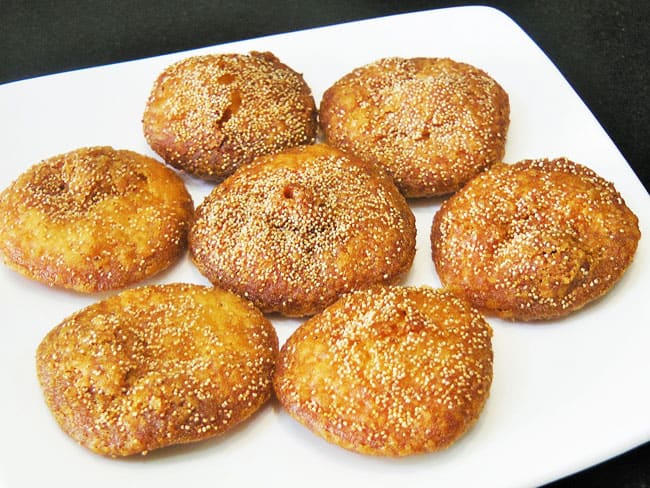Anarsa: Meetha Magic for Diwali Dhamaka!
Namaste and Pranam, my foodie friends! Chef Curry Do’pyaza here, ready to sprinkle some sugary goodness into your lives. How are you all doing? I hope you are having a great time with your family and friends. Today, we are diving deep into the sweet, nutty world of Anarsa, a traditional treat that’s as delightful to make as it is to eat.
Think of Anarsa as little bites of happiness, a reminder of simpler times and festive cheer.
When Do We Whip Up This Sweet Treat?
Anarsa is a star during Diwali, the festival of lights! Imagine tiny, golden discs twinkling on your Diwali thali alongside diyas. It is also popular during other auspicious occasions like weddings and Ganesh Chaturthi, especially in Maharashtra and other parts of India. It’s a sweet symbol of prosperity and good luck, often made with love by mothers and grandmothers.
A Little Trip Down Memory Lane
The history of Anarsa is a bit like a delicious secret whispered through generations. It is believed to have originated in Maharashtra, India. The recipe has been passed down through families, each adding their own special touch. It’s a rustic sweet, a testament to the ingenuity of home cooks using simple ingredients to create something truly special.
Let’s Get Cooking!
Here is your chance to make this beautiful dish at home.
- Preparation Time: 24 hours (mostly soaking!)
- Cooking Time: 20-25 minutes
What You Will Need (Ingredients):
- 2 cups Chawal (Rice), preferably short-grain like Ambemohar or Kolam
- 1 cup Gur (Jaggery), grated or finely chopped
- 1/2 cup Khus Khus (Poppy Seeds)
- 2 tablespoons Ghee (Clarified Butter)
- Oil, for deep frying
- A pinch of Elaichi (Cardamom) powder (optional, for extra flavour)
Let’s Make Some Anarsa!
- The Rice Soak: Wash the rice thoroughly. Soak it in plenty of water for at least 24 hours. Change the water every 6-8 hours. This is crucial! We want the rice to be nice and soft.
- Grind Time: After 24 hours, drain the rice completely. Spread it on a clean cotton cloth and let it dry for about an hour. The rice should be damp, not dripping wet. Now, grind the rice into a fine powder. You can use a blender or a traditional stone grinder for this.
- Jaggery Magic: In a large bowl, mix the rice flour and grated jaggery. Add a pinch of cardamom powder if you are using it. Mix everything really well with your hands. The mixture should come together like a dough. If it is too dry, add a teaspoon of milk or water at a time.
- Rest and Relax: Cover the dough and let it rest for at least 4 hours, or even overnight, in the refrigerator. This allows the flavors to meld together beautifully.
- Shape and Sprinkle: Take a small portion of the dough (about a tablespoon) and flatten it gently into a small disc, about 2 inches in diameter. Sprinkle poppy seeds generously on both sides of the disc, pressing them in lightly.
- Fry Time! Heat oil in a deep pan or kadai over medium heat. Gently slide the Anarsa into the hot oil, one or two at a time. Fry them until they turn golden brown and crispy on both sides. This should take about 2-3 minutes per side.
- Drain and Cool: Remove the Anarsa from the oil and place them on a paper towel to drain excess oil. Let them cool completely before storing them in an airtight container.
Chef Curry’s Top Tips for Anarsa Perfection:
- Rice is Key: The quality of rice makes a big difference. Use good quality, short-grain rice for the best results.
- Drying is Important: Don’t let the rice dry completely after soaking. It should be damp, not bone dry.
- Jaggery Consistency: Make sure the jaggery is finely grated or chopped. This helps it mix evenly with the rice flour.
- Low and Slow: Fry the Anarsa on medium heat to ensure they cook evenly and turn golden brown. High heat will burn them on the outside while leaving the inside raw.
- Patience is a Virtue: Don’t overcrowd the pan while frying. Fry them in batches to maintain the oil temperature.
Anarsa, Your Way! (Cooking Variations)
- Gas Stove: Follow the instructions above for deep frying in a kadai or deep pan.
- Induction Stove: The same as gas stove cooking. Ensure the induction stove is set to medium heat for frying.
- Air Fryer: Preheat your air fryer to 350°F (175°C). Place the Anarsa in a single layer in the air fryer basket. Air fry for 8-10 minutes, flipping halfway through, until golden brown. This is a healthier alternative to deep frying!
- Oven: Preheat your oven to 350°F (175°C). Place the Anarsa on a baking sheet lined with parchment paper. Bake for 12-15 minutes, or until golden brown.
A Little Bit About Nutrition
Anarsa is a sweet treat, so it’s best enjoyed in moderation. It provides carbohydrates from the rice and jaggery, and a small amount of fat from the ghee and oil. Poppy seeds are a good source of minerals like calcium and iron.
Serving Suggestions
- Enjoy Anarsa as a standalone sweet snack.
- Serve it as part of a festive platter with other Indian sweets and savories.
- Pair it with a cup of hot chai or coffee.
Time to Get Cooking!
So, there you have it! A simple, yet incredibly delicious recipe for Anarsa. I encourage you to try this recipe at home and share the joy with your friends and family. Trust me, the sweet, nutty flavor of Anarsa is sure to bring a smile to everyone’s face.
Happy cooking, my friends! And may your Diwali be filled with light, love, and lots of delicious Anarsa!
Until next time,
Chef Curry Do’pyaza, signing off!
